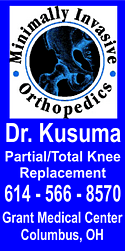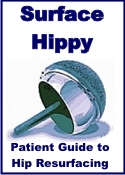|
|
||||||||||||||||
What is arthritis and why does my knee hurt?
In the knee joint there is a layer of smooth cartilage between the
end of the thighbone and the top of the calf bone. This cartilage
serves as a cushion and allows for smooth motion of the knee.
Arthritis is a wearing away of this cartilage. Eventually it wears
down to bone. Rubbing of bone against bone causes discomfort,
swelling and stiffness. Pain in commonly in the knee but may radiate
to the thigh, calf. or back of the knee. It will often hurt worse
after periods of immobility. Most knees wear out on the inside first
followed by the outside and kneecap. A total knee replacement is an operation that removes the arthritic bone and damaged cartilage from the knee joint. The knee is replaced with a metal and plastic covering that simulates the natural cartilage. This creates a smoothly functioning joint that does not hurt. The natural tendons and muscles are left in place to allow the joint to function smoothly. What is a unicompartmental replacement?
A unicompartmental or uni replacement is appropriate for patients
that have only one side or compartment of their knee worn out. These
patients will have very specific pain on the inside or outside of
their knees and little to no pain while climbing stairs. Only 20% of
our patients are good candidates for uni or partial replacement. The
recovery time is shorter and rehab is much easier, but the
prosthesis tends to wear out sooner than a total knee replacement.
Ask Dr. Waldman if you think you are a candidate for this kind or
knee replacement.
95% or our patients experience good or excellent results after the
initial healing period. They have little to no pain and are able to
enjoy a wide variety of activities with few restrictions. Most can
pursue moderate exercise, walk long distances, dance or play active
sports.
The decision is based on your history, exam and x-rays. There is
usually no harm in waiting if conservative, non-operative methods
are controlling your discomfort. When these methods no longer
control your pain, surgery is usually indicated.
Age is not an issue if you are in reasonable health and have the
desire to continue living a productive, active life. You may be
asked to see your personal physician for his/her opinion about your
general health and readiness for surgery.
All implants have a limited life expectancy depending on an
individual’s age, weight, activity level and medical condition. A
total joint implant’s longevity will vary in every patient. the
current combination of components used by Dr. Waldman have a 94% 15
year survival rate. Some of these implants may last much longer.
Wearing of the plastic spacer may result in the need for a new
liner. However, only 7% of patients nationally ever require a
revision and implants continue to improve.
Most operations go extremely well, without any complications.
Infection and blood clots are two serious complications that can
occur. To avoid these complications, we use antibiotics and blood
thinners. We also take special precautions in the operating room to
reduce the risk of infections. Dr. Waldman’s current infection rate
is 0.7% and the symptomatic blood clot rate is 0%.
Yes, exercise will do no further harm to your knee and will help to
make rehabilitation easier after the surgery. Will I need blood?
The chance of needing blood after the surgery is about 20%. This
rate is lower in men and in relatively healthy woman. We generally
don’t recommend donating blood because much of it is wasted.
Additionally, the community blood supply is in general, very safe.
Banked blood is considered very safe and complications are rate.
You will probably stay in bed the day of your surgery. However, the
next morning most patients will get up, sit in a chair or recliner
and should be walking with a walker or crutches later that day. Most
patients can try steps the second day after the surgery.
Most knee patients will be hospitalized for three days after their
surgery. There are several goals that you must achieve before you
can be discharged. Our rehabilitation physicians will evaluate your
progress two days after the surgery, and recommend a rehabilitation
stay if necessary. This stay may last anywhere from three days to
two weeks.
The Rubin Institute is a stand alone hospital attached to Sinai
Hospital. It provides specialized orthopaedic care to joint
patients, physical therapy facilities and houses a number of ongoing
research projects. Dr. Waldman is director of the joint replacement
program at the Rubin Institute.
Most patients who live alone will qualify for inpatient
rehabilitation. When patients leave rehab, they should be able to
care for themselves independently.
The office secretary will contact your insurance company to
pre-authorize your surgery. It is exceedingly rare that a second
opinion is required by an insurance company. If a second opinion is
required, you will be notified.
We reserve approximately 2½ - 3 hours for surgery. Some of this time
is taken by the operating room staff to prepare for the surgery and
to prepare the room for the next operation. The actual surgery takes
about one hour.
You may have a general anesthetic, which most people call “being put
to sleep.” In most patients we recommend a spinal anesthetic, which
numbs only your legs and does not require you to be asleep. In
general, spinals are more pleasant and provide better pain relief,
however, choice is made individually for each patient after
discussion with the anesthesiologist.
You will have discomfort following the surgery, but we will try to
keep you as comfortable as possible with the appropriate medication.
Most patients control their own medicine with a special pump that
delivers the drug directly into their IV for the first day.
Generally most patients are able to stop very strong medication
within a few days.
Dr. Waldman will perform the surgery. Jonas Griffin, PA-C assists on
most of the procedures. We often have a resident physician there to
assist and to help take care of you after the surgery. They are
there to learn and not to perform your surgery.
The scar will be approximately four to five inches long in most
patients. The length of the scar is somewhat proportional to the
size of the patient. It will be along the front of your knee.
Yes, for about three weeks we do recommend that you use a walker or
crutches. The hospital will help provide these items if necessary.
Most patients can use a cane for three to four weeks after the
walker or crutches are discontinued. Your physical therapist will
help to determine when you will advance from walker to cane to no
assistance.
Most patients are able to go home directly after discharge. Some
patients may transfer to an acute or sub-acute rehabilitation
facility and stay there for 3–14 days. Many patients are transferred
to Sinai Rehabilitation on the 5th floor of the main hospital, so no
travel is needed. The social worker will help you with this decision
and make the necessary arrangements.
Yes, we will arrange for a physical therapist to provide therapy at
your home. Following this, you may go to an outpatient facility two
to three times a week to assist in your rehabilitation. The length
of time required for this type of therapy varies with each patient.
If the surgery was on your left knee and you have an automatic
transmission, you could be driving at three weeks. If the surgery
was on your right knee, your driving could be restricted as long as
six weeks. Getting “back to normal” will depend somewhat on your
progress.
We recommend that most people take at least six weeks off from work,
unless their jobs are quite sedentary and they can return to work
with crutches. An occupational therapist can make recommendations
for joint protection and energy conservation on the job.
You will be seen for your first postoperative office 6 weeks after
the surgery. The frequency of follow-up visits after that will
depend on your progress. Many patients are seen at six weeks, four
months and then yearly.
Knee patients generally have no restrictions during the healing
process. Activity is limited by swelling, but not to protect the new
knee parts from harm.
You are encouraged to participate in low-impact activities such as
walking, dancing, golf, hiking, swimming, bowling and gardening.
More aggressive sports are often possible, so please ask us about
any specific activities you would like to pursue.
In many cases, patients with knee replacements think that the new
joint feels completely natural. The leg with the new knee may be
slightly longer than it was before, either because of previous
shortening due to the knee disease or because of a need to lengthen
the knee to avoid dislocation. Most patients get used to this
feeling in time or can use a small lift in the other shoe. Some
patients have aching in the thigh on weight bearing for a few months
after surgery. |
|
|||||||||||||||
|
Web design by Patricia Walter
Copyright Knees For You 12/18/2006
This site is published by Joint Health Sites
LLC, which is solely responsible for its content. |
||||||||||||||||





